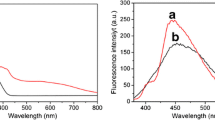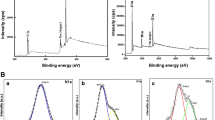Abstract
We propose an alternative approach for the development of analytical methods based on terbium-sensitized luminescence (TSL). TSL is based on the complexation between Tb(III) ions and fluorescent organic compounds that have appropriate functional groups to complex with Tb(III). We report the use of graphene quantum dot (GQDs) nanoparticles to improve the sensitivity and selectivity of TSL detection. GQDs can react with terbium ions through the carboxylic groups present in their structure. These Tb(III)–GQD complexes, formed in situ in aqueous solution, can be used as time-resolved luminescent probes. Ascorbic acid was selected as a target analyte to demonstrate the suitability of the proposed method. The selectivity of the TSL method was highly improved for most of the interferences tested. Under the optimum conditions [Tb(III) concentration 5 × 10-4 mol L-1, GQD concentration 4 mg L-1], a minimum 100% increase in selectivity was observed for several vitamins and common cations that may be present in the samples to be analyzed. In addition, the analytical signal showed a 30% enhancement with the use of GQDs compared with the use of merely Tb(III) ions, with a detection limit of 0.12 μg mL-1. The repeatability and intermediate precision were lower than 3% and 5%, respectively. From the results obtained, the implementation of GQDs in TSL can lead to the development of novel time-resolved luminescent probes with high analytical potential.

Quenching of Tb(III)–graphene quantum dot (GQD) luminescence by ascorbic acid (AA). TBL terbium-sensitized luminescence





Similar content being viewed by others
References
Ruiz-Medina A, Llorent-Martínez EJ, Ortega-Barrales P, Fernández-de Córdova ML. Lanthanide-sensitized luminescence as a promising tool in clinical analysis. Appl Spectrosc Rev. 2011;46:561–80.
Georges J. Lanthanide-sensitized luminescence and applications to the determination of organic analytes. A review. Analyst. 1993;118:1481–6.
Gómez-Hens A, Aguilar-Caballos MP. Terbium-sensitized luminescence: a selective and versatile analytical approach. Trends Anal Chem. 2002;21:131–41.
Al-Kindy SMZ, Suliman FEO. Determination of ibuprofen in pharmaceutical formulations using time-resolved terbium-sensitized luminescence. Luminescence. 2007;22:294–301.
Arnaud N, Georges J. Comprehensive study of the luminescent properties and lifetimes of Eu3+ and Tb3+ chelated with various ligands in aqueous solutions: Influence of the synergic agent, the surfactant and the energy level of the ligand triplet. Spectrochim Acta A. 2003;59:1829–40.
Guo C, Wang L, Hou Z, Jiang W, Sang L. Micelle-enhanced and terbium-sensitized spectrofluorimetric determination of gatifloxacin and its interaction mechanism. Spectrochim Acta A. 2009;72:766–71.
Cuenca-Trujillo RM, Ayora-Cañada MJ, Molina-Díaz A. Determination of ciprofloxacin with a room-temperature phosphorescence flow-through sensor based on lanthanide-sensitized luminescence. J AOAC Int. 2002;85:1268–72.
Llorent-Martínez EJ, Ortega-Barrales P, Molina-Díaz A, Ruiz-Medina A. Implementation of terbium-sensitized luminescence in sequential-injection analysis for automatic analysis of orbifloxacin. Anal Bioanal Chem. 2008;392:1397–403.
Shen J, Zhu Y, Yang X, Li C. Graphene quantum dots: emergent nanolights for bioimaging, sensors, catalysis and photovoltaic devices. Chem Commun. 2012;48:3686–99.
Li L, Wu G, Yang G, Peng J, Zhao J, Zhu J-J. Focusing on luminescent graphene quantum dots: current status and future perspectives. Nanoscale. 2013;5:4015–39.
Amjadi M, Shokri R, Hallaj T. A new turn-off fluorescence probe based on graphene quantum dots for detection of Au(III) ion. Spectrochim Acta A. 2016;153:619–24.
Bian S, Chao S, Hua H, Zhou L, Zhu H, Xi F, et al. One-pot synthesis of sulfur-doped graphene quantum dots as a novel fluorescent probe for highly selective and sensitive detection of lead(II). RSC Adv. 2016;6:69977–83.
Tabaraki R, Nateghi A. Nitrogen-doped graphene quantum dots: "turn-off" fluorescent probe for detection of Ag+ ions. J Fluoresc. 2016;26:297–305.
Lin L, Song X, Chen Y, Rong M, Wang Y, Zhao L, et al. Europium-decorated graphene quantum dots as a fluorescent probe for label-free, rapid and sensitive detection of Cu2+ and L-cysteine. Anal Chim Acta. 2015;891:261–8.
Liu Y, Zhou S, Fan L, Fan H. Synthesis of red fluorescent graphene quantum dot-europium complex composites as a viable bioimaging platform. Microchim Acta. 2016;183:2605–13.
Weng H, Yan B. N-GQD and Eu3+ co-encapsulated anionic MOFs: two-dimensional luminescent platform for decoding benzene homologues. Dalton Trans. 2016;45:8795–801.
Spínola V, Llorent-Martínez EJ, Castilho PC. Determination of vitamin C in foods: current state of method validation. J. Chromatogr A. 2014;1369:2–17.
Pisoschi AM, Pop A, Serban AI, Fafaneata C. Electrochemical methods for ascorbic acid determination. Electrochim Acta. 2014;121:443–60.
Liu S, Hu J, Su X. Detection of ascorbic acid and folic acid based on water-soluble CuInS2 quantum dots. Analyst. 2012;137:4598–604.
Mi C, Wang T, Zeng P, Zhao S, Wang N, Xu S. Determination of ascorbic acid via luminescence quenching of LaF3:Ce,Tb nanoparticles synthesized through a microwave-assisted solvothermal method. Anal Methods. 2013;5:1463–8.
Duran GM, Benavidez TE, Contento AM, Ríos A, Garcia CD. Analysis of penicillamine using Cu-modified graphene quantum dots synthesized from uric acid as single precursor. J Pharm Anal. https://doi.org/10.1016/j.jpha.2017.07.002.
International Conference on Harmonisation of Technical Requirements for Registration of Pharmaceuticals for Human Use. ICH harmonised tripartite duideline. Validation of analytical procedures: text and methodology Q2(R1). 2005. http://www.gmp-compliance.org/guidemgr/files/Q2(R1).PDF
Wang X, Wu P, Hou X, Lv Y. An ascorbic acid sensor based on protein-modified Au nanoclusters. Analyst. 2013;138:229–33.
Rao H, Gao Y, Ge H, Zhang Z, Liu X, Yang Y, et al. An “on-off-on” fluorescent probe for ascorbic acid based on Cu-ZnCdS quantum dots and α-MnO2 nanorods. Anal Bioanal Chem. 2017;409:4517–28.
Niu W-J, Shan D, Zhu R-H, Deng S-Y, Cosnier S, Zhang X-J. Dumbbell-shaped carbon quantum dots/AuNCs nanohybrid as an efficient ratiometric fluorescent probe for sensing cadmium (II) ions and l-ascorbic acid. Carbon. 2016;96:1034–42.
Liu J-J, Chen Z-T, Tang D-S, Wang Y-B, Kang L-T, Yao J-N. Graphene quantum dots-based fluorescent probe for turn-on sensing of ascorbic acid. Sens Actuators B. 2015;212:214–9.
Liu R, Yang R, Qu C, Mao H, Hu Y, Li J, et al. Synthesis of glycine functionalized graphene quantum dots as highly sensitive and selective fluorescent sensor of ascorbic acid in human serum. Sens Actuators B. 2017;241:644–51.
Tan H, Wu J, Chen Y. Terbium (III) based coordination polymer microparticles as a luminescent probe for ascorbic acid. Microchim Acta. 2014;181:1431–7.
González AG, Herrador MA, Asuero AG. Intra-laboratory testing of method accuracy from recovery assays. Talanta. 1999;48:729–36.
Acknowledgements
The following funding is acknowledged: CTQ2016-78793-P and CTQ2016-7511-R (Spanish Ministry of Economy and Competitiveness, MINECO), PEIC-2014-001-P (Junta de Comunidades de Castilla-La Mancha, JCCM) and DIPUCR-16-LLORENTMARTINEZ (Diputación de Ciudad Real). EJLM also acknowledges the financial support from the University of Castilla-La Mancha Research and Mobility Plans.
Author information
Authors and Affiliations
Corresponding author
Ethics declarations
Conflict of interest
The authors declare that they have no competing interests.
Rights and permissions
About this article
Cite this article
Llorent-Martínez, E.J., Durán, G.M., Ríos, Á. et al. Graphene quantum dots–terbium ions as novel sensitive and selective time-resolved luminescent probes. Anal Bioanal Chem 410, 391–398 (2018). https://doi.org/10.1007/s00216-017-0728-5
Received:
Revised:
Accepted:
Published:
Issue Date:
DOI: https://doi.org/10.1007/s00216-017-0728-5




